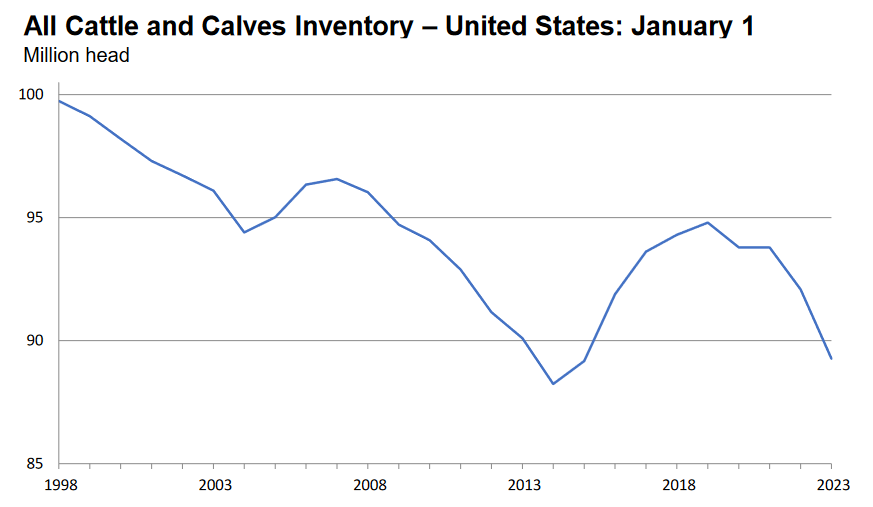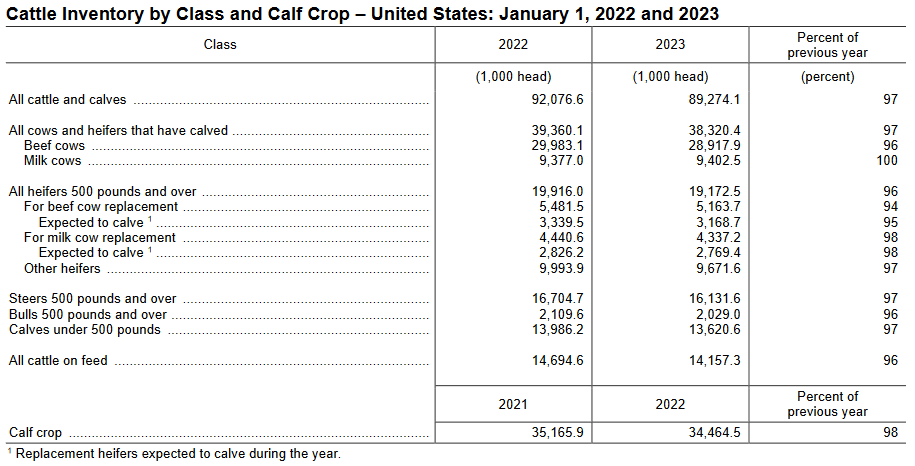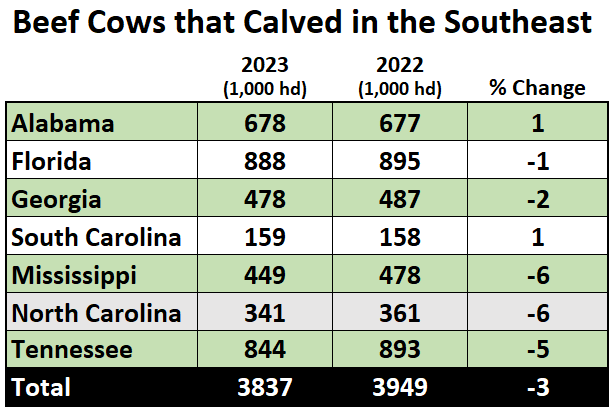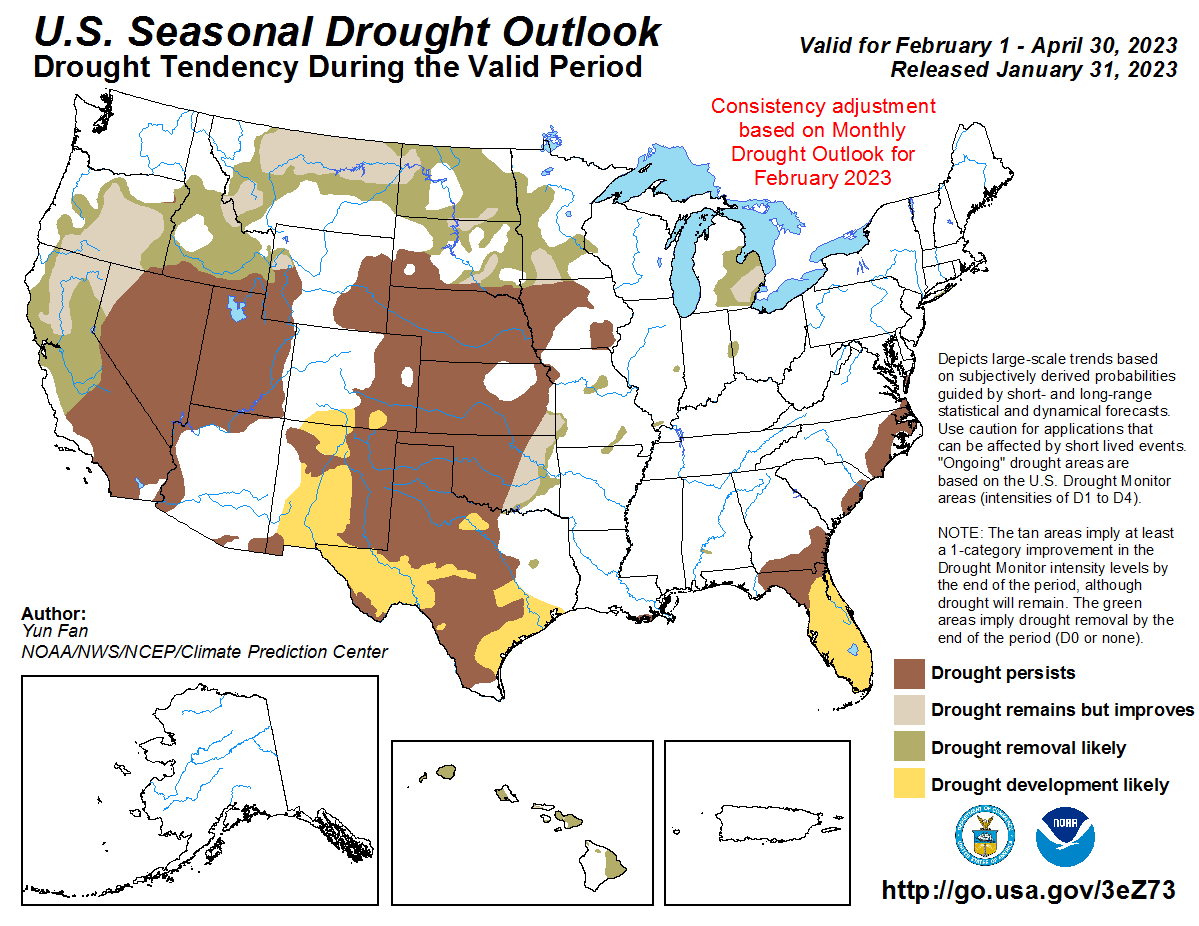USDA’s National Agricultural Statistic Service (NASS) released the January 1 Cattle Inventory Report on January 31, 2023. NASS estimates the national cattle inventory twice per year, on January 1 and July 1. These reports can be a little confusing, as the year listed is the date of the report, but these reports actually document changes to the national cattle inventory for the previous six months, so what is marked as 2023 on the chart above is really where we stood at the end of 2022. The national cattle inventory declined for the fourth straight year since the recent peak of 94.8 million in 2018. According to NASS, there were 89.3 million cattle in the U.S. at the end of 2022, which was a 3% drop from the previous year, and a total decline of almost 6% since the peak of 2018.
–
–
When you look at the inventory by class in the chart above, you can see that the backup of cattle moving through feedyards, caused by pandemic issues with slaughter plants, has ended and there were 3% fewer cattle being fed at the end of 2022. The beef cow herd dropped from almost 30M to below 29M, down 4%. Yearling replacement heifers dropped 6%, and bred two-year old first-calf heifers were down 5%. Dairy cattle were the only class of cattle remained fairly constant with a slight increase of 26K from the previous year. Yearling and bred dairy heifers dropped 2%, so there will be fewer dairy cattle in the near future.
–
–
When you look through the beef herd numbers in the Southeast, you can see that overall, there were 112 K fewer beef cows that calved last year, down 3% compared to the previous year. In Florida there were 7,000 fewer beef cows that calved, or 1% fewer than the previous year.
–
So what does this mean for local cattle ranchers?
Cattle Fax provided an Economic Outlook Seminar this week at the National Cattlemen’s Beef Association (NCBA) Cattle Industry Convention in New Orleans, Louisiana. The following are a few excepts from the NCBA News Release following the event.
Prices and profitability will again favor cattle producers in 2023. The cattle industry is entering 2023 with the smallest cattle supply since 2015, as drought caused the industry to dig deeper into the supply of feeder cattle and calves. While the exact path to drought relief is unknown, improvements are also expected to translate to moderating feed costs, especially in the second half of 2023. Combined with increased cattle prices, cattle producers, especially the cow-calf operator, will continue to see an improvement in margins for the next several years.
–
The forecast average 2023 fed steer price is $158/cwt., up $13/cwt. from 2022, with a range of $150 to $172/cwt. throughout the year. All cattle classes are expected to trade higher, and prices are expected to continue to trend upward. The 800-lb. steer price is expected to average $195/cwt. with a range of $175 to $215/cwt., and the 550-lb. steer price is expected to average $225/cwt., with a range of $200 to $245/cwt. Cull cows are expected to average $100/cwt., with a range of $75 to $115/cwt, and bred cows an average of $2,100/cwt. with a range of $1,900 to $2,300 for load lots of quality, running-age cows.
–
Expect an overall positive outlook, with improvements in the weather pattern and a tighter cattle supply to distribute more money though all sectors of the cattle industry. Matt Makens, Kevin Good, & Randy Blach, Cattle Fax
–
This is good news for the cattle producers in Gulf Coast states, where drought was not as severe, that hung on to most of their cows last year. If you stuck it out through the hard times of 2020-22, it does appear that your reward is coming in the next few years. There will be fewer cattle available, so if demand for beef remains strong, cattle prices will continue to improve. The Cattle Fax outlook that was shared in New Orleans should give you hope. This is a positive outlook, but what costs will do is the big variable of concern. Managing costs will still be vitally important in 2023, but it does appear cattlemen will have more income and significantly improve their opportunity to be profitable. The other big variable is the drought situation.
–
The U.S. Drought is not over, but the seasonal drought outlook above (January 31) does offer some hope of recovery for large areas in grey and green. But you can see that there are still large areas of brown and yellow that are not expected to see improvement within the next three months. Notice most of Florida is included in the drought development or persistence categories, except for the central time zone counties in the Panhandle. The cattle industry depends on forage and grain production, so drought will still be a significant issue in the western corn belt in 2023. Based on this forecast above, we can’t expect feed costs to drop significantly. The moisture this winter may help some areas of the country may restore pastures and native range, but it takes years to rebuild a breeding herd.
There are many factors that affect the overall profitability of cow-calf producers. Basic economics dictate that income must be grater than expenses to remain profitable and sustainable. If you stuck it out through the hard times of the previous three years, congratulations. The outlook for 2023 is certainly more positive than in 2022 or 2021. In 2014, every cow-calf producer smiled when they sold weaned calves for more than $2/lb. You may have that opportunity again this year, but it won’t be the same with much higher production costs. Even so, $2/lb. for five-weight weaned steers is encouraging. 2024 should be even better, as the 2023 calf crop will be smaller than 2022, because there were 4% fewer beef cows and 5% fewer pregnant heifers at the end of the year. We live in a global economy now, so there will likely be more beef that gets imported this year, but this will primarily be ground beef, as most countries can’t compete with the meat quality we can produce in the US. Now is the time to start thinking again about improving production to take advantage of higher income opportunities. 2023 will likely still be a challenging year for cow-calf producers, but the outlook is more positive than it has been the last few years.
–
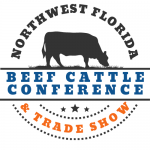 The 2023 Beef Cattle Conference presentations will focus on improving the health, performance, and profitability of cow-calf herds. Reserve your seat at the upcoming Northwest Florida Beef Cattle Conference & Trade Show, to be held February 8, 2023, in Marianna. There will be five presentations that should help producers prepare to manage in the years ahead. There will also be a Trade Show of more than 20 companies and organizations that provide products and services to cattle producers in the region. Come get ideas and find out what services and products are available to help your cattle operation be more profitable in 2023. Use the following link for advanced registration.
The 2023 Beef Cattle Conference presentations will focus on improving the health, performance, and profitability of cow-calf herds. Reserve your seat at the upcoming Northwest Florida Beef Cattle Conference & Trade Show, to be held February 8, 2023, in Marianna. There will be five presentations that should help producers prepare to manage in the years ahead. There will also be a Trade Show of more than 20 companies and organizations that provide products and services to cattle producers in the region. Come get ideas and find out what services and products are available to help your cattle operation be more profitable in 2023. Use the following link for advanced registration.
–
Beef Cattle Conference & Trade Show Registration
- Friday Feature:Malone Pecan Festival Tractorcade - November 21, 2025
- October 2025 Weather Summary and Winter Outlook - November 14, 2025
- Friday Feature:The Untold Story Behind the Beef for Dinner Tune - November 14, 2025

